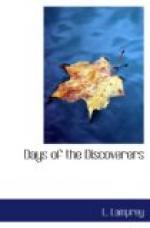It did not take the trader long to make up his mind. He went with the Indians at the slow trot which covers so many miles in a day, and sooner than they had expected, they saw from a little rise in the ground a vast herd of slowly moving animals which at first the white man took for black cattle. But they were not cattle.
There was the huge hump with the curly mane, and there were the short horns and slender, neat little legs which had seemed so out of proportion in the old Indian’s sketch. From their point of view they could see the hunters cut out one animal and attack him with their arrows and lances without arousing the fears of the rest. The creatures moved quietly along, grazing and pawing now and then, darkening the plain almost as far as the eye could see. The trader spent several days with the tribe, and when he went south again he had a bundle of hides so large that he had to drag it on a kind of hurdle made of poles. He had helped the Indians decorate some of the hides they had, and whenever he did this he wrote his own name, the date, and a few words, somewhere on the skin.
[Illustration: “THE CREATURES DARKENED THE PLAIN ALMOST AS FAR AS EYE COULD SEE.”—Page 191]
“Why do you do this?” asked the medicine man, putting one long bronze finger on the strange marks.
“It is a message,” said Cabeca de Vaca. “If any of my own people see it they will know who made the pictures.”
The Indian looked at him thoughtfully.
“You are very clever,” he said. “You ought to be a medicine-man.”
This put another idea into the exile’s head. He had seen much of the medicine-men in his wanderings, and had studied their ways. Like most men of his day who traveled much, he had a rough-and-ready knowledge of medicine and surgery. He had sometimes been able to be of service to sick and wounded Indians, and whether it was their faith in him, or in the virtues of his treatment, his patients usually got well. In comparing notes they found that he often prayed and sang in his own language while watching with them. In the end he gained a great reputation as a sort of combined priest and doctor. He was not too proud to adopt some of the methods of the medicine-men when he found them effective, especially as regards herbs and other healing medicaments, used either in poultices or drinks. From being a poor slave and a burden to his masters, he became their great man.




